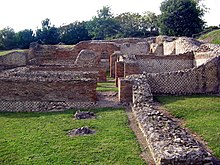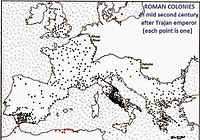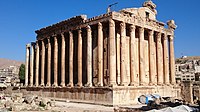Aeclanum
Aeculanum | |
 View of the thermae with the opus reticulatum brickwork | |
| Location | Mirabella Eclano (Province of Avellino, Italy) |
|---|---|
| Region | Campania |
| Coordinates | 41°3′14″N 15°0′40″E / 41.05389°N 15.01111°E |
| Type | Settlement |
| History | |
| Periods | Roman Republic – Byzantine Empire |
| Cultures | Samnites – Ancient Rome |
| Site notes | |
| Archaeologists | Italo Sgobbo |
| Management | Soprintendenza per i Beni Archeologici di Salerno, Avellino, Benevento e Caserta |
| Public access | Yes |
| Website | Aeclanum |
Aeclanum (also spelled Aeculanum,
Passo di Mirabella, near the modern Mirabella Eclano
.
It is now an
archaeological park
.

Location
Aeclanum was on a promontory naturally defended, to some extent, by a steep slope on the south side down to the river Calore, while the north side lay open towards the crest of the ridge where the
) may also follow an ancient line.Today there are ruins of the city walls, of an
aqueduct, baths and an amphitheatre; nearly 400 inscriptions have also been discovered. Excavation has revealed a long history of pre-Roman settlement.[2][3][4]
History
Aeclanum was a town of the
Sulla captured it in 89 BC by setting on fire the wooden breastwork by which it was defended, and sacked it. It quickly recovered, new fortifications were erected, and it became a municipium. Hadrian, who repaired the Via Appia from Beneventum to this point, made it a colonia
(colony).
With the Lombard invasion of Italy, in the 6th century AD, it was annexed to the Duchy of Benevento, but was captured and destroyed by Eastern Roman forces under Constans II in 663 and never recovered, being reduced to a small hamlet known as Quintodecimo, a name that referred to its distance of 15 Roman miles from Benevento.[2][3]
Bishopric
Aeclanum became a
suffragan see of Benevento in 969 and 1058. From 1059 it was definitively united with Frequentium.[5][6] No longer a residential bishopric, Aeclanum is today listed by the Catholic Church as a titular see.[7]
Gallery
-
The central road
-
Remains of the houses (1)
-
Remains of the houses (2)
-
Side view of the thermae
References
- ^ (in Italian) Aeclanun on the Italian Encyclopedia Treccani
- ^ a b "AECLANUM (Eclano) Italy" in The Princeton Encyclopedia of Classical Sites
- ^ a b One or more of the preceding sentences incorporates text from a publication now in the public domain: Chisholm, Hugh, ed. (1911). "Aeclanum". Encyclopædia Britannica. Vol. 1 (11th ed.). Cambridge University Press. p. 244.
- ^ Aeclanum
- ^ Giuseppe Cappelletti, Le Chiese d'Italia dalla loro origine sino ai nostri giorni, Venezia 1864, vol. XIX, p. 180
- ^ "Storia della diocesi di Avellino". Archived from the original on 2016-03-03. Retrieved 2014-10-01.
- ISBN 978-88-209-9070-1), p. 884
External links
Wikimedia Commons has media related to Aeclanum.
- (in Italian) Aeclanum (Cultural Property of Campania website)
- (in Italian) Aeclanum (Mirabella Eclano municipal website)










